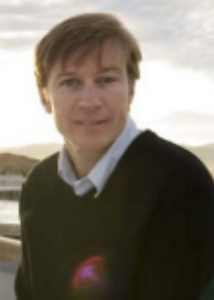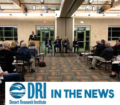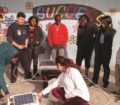By Jane Palmer
March 2016
Eric Wilcox is an associate Professor in Climatology in the Division of Atmospheric Sciences at the Desert Research Institute where he investigates the interactions among aerosols, clouds, and precipitation and the impacts of these interactions on climate. It’s work that relies on satellite and in-situ observations, as well as simulations with numerical models of the atmosphere and climate. At the Solar Energy-Water-Environment Nexus in Nevada Annual and EAC Meeting 2016, I talked to Eric about how he is bringing his expertise to bear on the solar energy forecasting.
So how does your work relate to the Nexus mission?
In the Nexus project, we look at, how clouds impact the generation of solar electricity. So when clouds block the sun, they shade the solar array and you get a rapid drop in the amount of power output. Then, when that cloud moves away, you get a surge as that PV array starts collecting a lot more solar energy.
Why would that present problems?
Because a utility wants to provide a steady supply of electricity. If you just have one solar array in a big city, it’s not really that important, but as you get more penetration of solar into the marketplace, particularly in these sunny, southwestern places, at some point those voltage variations from the variability of cloudiness, start to actually impact the reliability and the quality of the electricity on the grid. So this becomes an engineering challenge.
So what are you trying to achieve with your work?
The idea of trying to forecast or anticipate fluctuations is not actually a new area, there are quite a few groups that are exploring approaches to doing that. What we really want to do is try to understand how those tools might be integrated into the actual management of the electrical grid that distributes power from solar panels to consumers.
That’s where the collaborative aspect of the NEXUS project comes into play because I’m not an engineer, but there are a lot of electrical engineers on this project and so by having access to those aspects of this project, I can start to ask the broader question of: If you have this information, how could it be used? How could it be used to provide a more reliable source of solar electricity?
Where do you hope to go next with this work?
I’m hoping to integrate our forecasting technology into the newly developed UNLV micro grid. They are testing new technology for its ability to smooth out variations in solar power output to the electricity grid. It is exactly these variations that we hope to anticipate by developing forecasting tools. So the micro grid is the natural place to see how we can combine forecasting technology with other smart grid technology with the goal of increasing the reliability of solar power on the electric grid.
What is exciting about this work for you?
What’s particularly interesting to me about this project is, instead of just retreading the ground that others in my area have already pioneered before, I have the chance to collaborate with engineers with real expertise in the solar energy.







